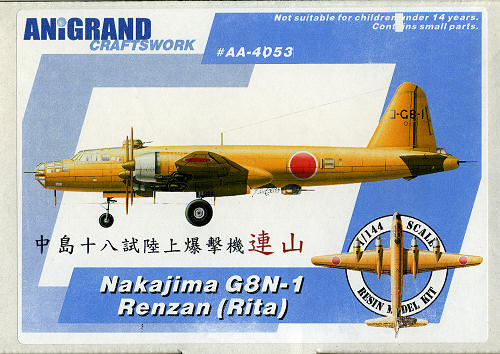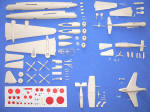
Anigrand 1/144 G8N1 'Renzan' (Rita)
| KIT #: | AA-4053 |
| PRICE: | $102.00 MSRP from www.nostalgicplastic.com |
| DECALS: | One option per aircraft |
| REVIEWER: | Scott Van Aken |
| NOTES: | Resin. Includes four additional models |

| HISTORY |
In February 1943 the Imperial Navy staff asked Nakajima Aircraft Company to design a four-engined bomber, capable of meeting an earlier specification set for a long-range land-based attack plane. The final specification, issued on 14 September 1943, called for a plane with a maximum speed of 320 knots (370 mph; 590 km/h) able to carry a 4,000 kg (8,800 lb) bomb-load 2,000 nmi (3,700 km; 2,300 mi) or a reduced bomb-load 4,000 nmi (7,400 km; 4,600 mi).
Nakajima's design featured a mid-mounted wing of small area and high aspect ratio, a tricycle landing gear and a large single-fin rudder. Power came from four 2,000hp Nakajima NK9K-L "Homare" 24 radial engines with Hitachi 92 turbosuperchargers driving four-bladed propellers. The engines were cooled by counter-rotating fans positioned just inside the engine cowlings. Defensive armament included power-operated nose, dorsal, ventral and tail turrets along with two free-swiveling machine guns at the beam positions.
The initial prototype was completed in October 1944 and delivered to the Navy for testing in January 1945, a mere one year after the Navy ordered development to start. Three further examples were completed by June 1945, with the third prototype being destroyed on the ground by US carrier aircraft.
Other than minor problems with the turbosuperchargers, the Renzan performed satisfactorily and the Navy hoped to have a total of 16 prototypes and 48 production-version G8N1s assembled by September 1945. But the worsening war situation and a critical shortage of light aluminum alloys led to the project's cancellation in June.
One proposed variant was the G8N2 Renzan-Kai Model 22, powered by four 2,200hp Mitsubishi MK9A radial engines and modified to accept attachment of the air-launched Ohka Type 33 Special Attack Bomber.
Just prior to Japan's surrender in August 1945 consideration was also briefly given to producing an all-steel version of the aircraft, to be designated G8N3 Renzan-Kai Model 23, but the cessation of hostilities precluded any further development.
| THE KIT |
 This
is yet another of Anigrand's superb multi-kit offerings in 1/144. The main act
in this play is the G8N kit. Like all of Anigrand's recent offerings, this resin
kit is very nicely molded in a tan resin with engraved panel lines and clear
resin parts. It is packaged in a segregated poly bag with each of the kits in
one bag and the clear bits in their own zip bag, also in a compartment of the
polybag. With all of the G8N bits in one compartment, I was pleased to see that
none of the prop blades had broken off, and also that I could not see any air
pockets, resin blobs or other detritus on the parts.
This
is yet another of Anigrand's superb multi-kit offerings in 1/144. The main act
in this play is the G8N kit. Like all of Anigrand's recent offerings, this resin
kit is very nicely molded in a tan resin with engraved panel lines and clear
resin parts. It is packaged in a segregated poly bag with each of the kits in
one bag and the clear bits in their own zip bag, also in a compartment of the
polybag. With all of the G8N bits in one compartment, I was pleased to see that
none of the prop blades had broken off, and also that I could not see any air
pockets, resin blobs or other detritus on the parts.
All of the kits have some interior with at least seats to provide some points of interest. The G8N has the entire nose and canopy section molded as a single piece, which is a great idea and should make it easier to attach this piece. There isn't a ton of room in the nose for weight and since the main gear angles forward, a lot of the weight of the model will be concentrated behind them.
The other four aircraft are a Ki-202 (basically an Me-163, the Ki-115 Tsuguri suicide plane and the Ta-go suicide plane which never made it off the ground. Also included is the Ki-119, a light bomber driven by a two bladed prop and carrying a single bomb externally. I found very little on this and do not think it ever made it to the prototype stage by the end of the war.
Instructions are typical of Anigrand with 3D artwork for the construction and the other side dedicated to colors and decal placement. There are two identical decal sheets provided that were also used for the G5N kit I built a while back. They provide your basic markings as these planes had little else.
| CONCLUSIONS |
This is another bargain kit set. Five full 1/144 kits of interesting late war Japanese aircraft all in one container. I fully plan on doing a full build on the G8N once a few other projects clear the way, so stay tuned.
| REFERENCES |
http://en.wikipedia.org/wiki/Nakajima_G8N
November 2010
Thanks to www.nostalgicplastic.com for the preview kit. Get yours today and pay no shipping in the US or Canada.
If you would like your product reviewed fairly and quickly, please contact me or see other details in the Note to Contributors.